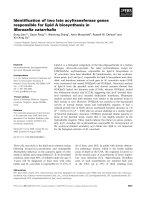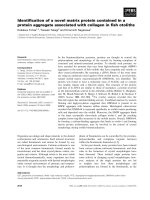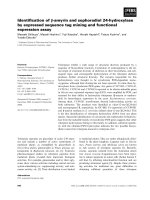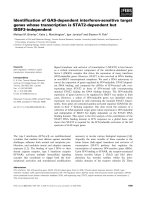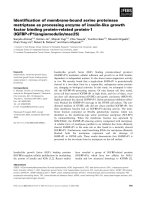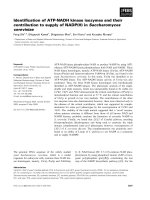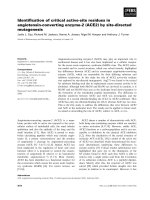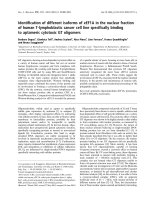Báo cáo khoa học: Identification of functional domains in the formyl peptide receptor-like 1 for agonist-induced cell chemotaxis doc
Bạn đang xem bản rút gọn của tài liệu. Xem và tải ngay bản đầy đủ của tài liệu tại đây (577.4 KB, 10 trang )
Identification of functional domains in the formyl peptide
receptor-like 1 for agonist-induced cell chemotaxis
Yingying Le
1,2
, Richard D. Ye
3
, Wanghua Gong
4
, Jianxiang Li
1
, Pablo Iribarren
1
and Ji Ming Wang
1
1 Laboratory of Molecular Immunoregulation, Center for Cancer Research, National Cancer Institute at Frederick, MD, USA
2 Institute for Nutritional Sciences, Shanghai Institutes for Biological Sciences, Chinese Academy of Sciences, Shanghai, China
3 Department of Pharmacology, College of Medicine, University of Illinois at Chicago, IL, USA
4 Basic Research Program, Center for Cancer Research, National Cancer Institute at Frederick, MD, USA
Leukocyte recruitment to sites of inflammation and
infection is dependent on the presence of a gradient of
locally produced chemotactic factors. The bacterial pep-
tide N-formyl-methionyl-leucyl-phenylalanine (fMLF)
is one of the first identified and highly potent leuko-
cyte chemoattractants [1–3]. fMLF interacts with at
least two human cell receptors formyl peptide receptor
(FPR) and its variant formyl peptide receptor-like 1
(FPRL1), both are members of the seven transmem-
brane domain, G protein-coupled receptor (GPCR)
family [4–6]. FPR is activated by picomolar to low
nanomolar concentrations of fMLF and is defined as
the high-affinity fMLF receptor. FPRL1 possesses
69% identity at the amino acid level to FPR and is
defined as the low-affinity fMLF receptor based on is
activation only by high concentrations of fMLF [4–6].
Both FPR and FPRL1 are expressed by phagocytic
leukocytes and have been detected in cells of nonhema-
topoietic origin [5,6]. However, compared with FPR,
FPRL1 appears to be expressed in an even greater
variety of cell types, including epithelial cells, resting
T lymphocytes, astrocytoma cells, neuroblastoma cells,
and microvascular endothelial cells [5,6]. Although the
importance of FPR in host defense against bacterial
Keywords
chemotaxis; formyl peptide receptor; formyl
peptide receptor-like 1; structure–function
Correspondence
J M Wang, LMI, CCR, NCI-Frederick, Bldg.
560, Rm 31-40, Frederick, MD 21702, USA
E-mail:
(Received 19 August 2004, revised 23
November 2004, accepted 3 December
2004)
doi:10.1111/j.1742-4658.2004.04514.x
Formyl peptide receptor-like 1 (FPRL1) is a seven transmembrane domain,
G protein-coupled receptor that interacts with a variety of exogenous and
host-derived agonists. In order to identify domains crucial for ligand recog-
nition by FPRL1, we used chimeric receptors with segments in FPRL1
replaced by corresponding amino acid sequences derived from the proto-
type formyl peptide receptor FPR. The chimeric receptors were stably
transfected into human embryonic kidney epithelial cells and the capacity
of the cells to migrate in response to formyl peptide receptor agonists was
evaluated. Our results showed that multiple domains in FPRL1 are
involved in the receptor response to chemotactic agonists with the sixth
transmembrane domain and the third extracellular loop playing a promin-
ent role. Interestingly, the N-terminus and a segment between the fourth
transmembrane domain and the third intracellular loop of FPRL1 are
important for receptor interaction with a 42 amino acid amyloid b peptide
(Ab
42
), an Alzheimer’s disease-associated FPRL1 agonist, but not with
MMK-1, a synthetic FPRL1 agonist, suggesting that diverse agonists may
use different domains in FPRL1. Considering the potential importance of
FPRL1 in inflammation and neurodegenerative diseases, the identification
of functional domains in this receptor will provide valuable information
for the design of specific receptor antagonists.
Abbreviations
Ab
42
, 42 amino acid amyloid b peptide; BSA, bovine serum albumin; DMEM, Dulbecco’s modified Eagle’s medium; fMLF, N-formyl-
methionyl-leucyl-phenylalanine; FPR, formyl peptide receptor; FPRL1, formyl peptide receptor-like 1; HEK293 cells, human embryonic kidney
epithelial 293 cells; LXA4, lipoxin A4; SAA, serum amyloid A; TM, transmembrane domain; W peptide, Trp-Lys-Tyr-Met-Val-
D-Met.
FEBS Journal 272 (2005) 769–778 ª 2005 FEBS 769
infections has been demonstrated by the increased sus-
ceptibility to Listeria monocytogene of mice depleted
of FPR1, the mouse homologue of human FPR [7],
the nonredundant biological role of FPRL1 has yet to
be clearly established.
Recent studies have identified a variety of host-
derived, and structurally unrelated peptide agonists for
FPRL1, such as the 42 amino acid form of b amyloid
peptide (Ab
42
) associated with Alzheimer’s disease [8],
the acute phase protein serum amyloid A (SAA) [9], a
fragment of the neutrophil antibacterial granule pro-
tein cathelicidin LL37 [10], and a peptide derived from
human prion protein [11]. The capacity of FPRL1 to
interact with diverse agonists suggests its potentially
broad role in the process of inflammation and amy-
loidogenic diseases. Thus, elucidation of domains in
FPRL1 crucial for its function will not only shed light
on the structural basis for recognition by this receptor
of agonists associated with different pathophysiological
conditions, but also provide leads to the design of
receptor antagonists. In this study, we evaluated the
function of various chimeric FPRL1 constructs by
replacing its segments with the corresponding seq-
uences derived from the prototype formyl peptide
receptor FPR. We report that multiple domains are
involved in FPRL1 interaction with its specific peptide
agonists, with a prominent role for the sixth trans-
membrane domain (TM) and the third extracellular
loop in mediating the chemotactic function of this
receptor. In addition, two defined FPRL1 agonists
Ab
42
and MMK-1 were found to use different domains
in the receptor.
Results
Human FPR and FPRL1 are highly homologous and
chimeric receptors based on their sequences may mini-
mize possible global conformational changes (Fig. 1).
To evaluate the relative contribution of several
domains in FPRL1 to its capacity to interact with
chemotactic agonists, we measured the migration of
HEK293 cells stably expressing chimeric formyl pep-
tide receptors. Figure 2A,B illustrates the putative
configuration of the wild-type FPR and its variant
FPRL1. Eight chimeric receptor constructs are shown
in subsequent figures with open circles denoting seg-
ments of FPR and filled circles FPRL1. Replacement
of the FPR segments with those from FPRL1 or vice
versa was contiguous but not overlapping (except for
chimera B, CH295-351) (Fig. 3). This approach per-
mits systematic evaluation of the impact of one
swapped segment at a time on receptor response to the
chemotactic agonists. Levels of cell-surface expression
of the wide-type and chimeric formyl peptide receptors
were examined by measuring the capacity of HEK293
cells transfected with the receptor cDNAs to bind a
radioiodinated synthetic peptide, W peptide (
125
I-labe-
led Wpep), which has been shown to bind and activate
both FPR and FPRL1 [14]. The data confirmed that
cells transfected with the receptors exhibited substan-
tial and comparable binding sites for
125
I-labeled Wpep
with similar estimated affinity (Table 1).
Four defined formyl peptide receptor agonists were
used to evaluate the chemotactic responses of HEK293
cells expressing wild-type or chimeric receptors. The
Fig. 1. Alignment of the deduced amino acid sequences of human FPRL1 and FPR. The entire FPRL1 sequence (upper) is shown and the
amino acids are numbered above the sequence. Residues of FPR that differ from FPRL1 are shown in the bottom. (A) One-residue gap (*)
is introduced in the sequence of FPR to allow linear alignment with the FPRL1. The location of predicted transmembrane domains (TM) are
underlined.
Functional domains in FPRL1 Y. Le et al.
770 FEBS Journal 272 (2005) 769–778 ª 2005 FEBS
bacterial peptide fMLF at low nanomolar concentra-
tions induces potent chemotactic response mediated by
FPR but is a poor chemotactic factor for FPRL1 in
the same concentration range [12], whereas the syn-
thetic peptide MMK-1, which is identified from a ran-
dom peptide library [13,14], is active only on FPRL1
in a low nanomolar concentration range [14]. Ab
42
, the
Alzheimer’s disease-associated FPRL1 agonist [8,15],
was also used to evaluate the contribution of FPRL1
domains to the receptor function. By contrast, the
synthetic peptide, W peptide, activates both FPR and
FPRL1 at nanomolar concentrations with higher effic-
acy on FPRL1 [14,16,17]. This peptide did not induce
significant chemotaxis of parental HEK293 cells [16]
(and data not shown). The specificity of the peptide
agonists on FPR and FPRL1 was tested on cells trans-
fected with wild-type receptors. HEK293 cells expres-
sing FPR migrate in response to low concentrations
of fMLF with an EC
50
of 0.1 nm and a maximal cell
response at 10 nm of fMLF (Fig. 2A). By contrast,
fMLF at up to 100 nm did not induce significant
migration of HEK293 cells expressing FPRL1
(FPRL1 ⁄ 293) (Fig. 2B), although these cells migrated
in response to the peptide MMK-1 at picomolar and
low nanomolar concentrations (Fig. 2C). MMK-1 is
not chemotactic for FPR ⁄ 293 cells in a wide concen-
tration range tested (Fig. 2C). Consistent with previous
results [8], Ab
42
induced chemotactic response in cells
expressing FPRL1 but not FPR (Fig. 2C). As predic-
ted, the bispecific chemotactic agonist W peptide
induced significant migration of both FPR⁄ 293 and
FPRL1 ⁄ 293 cells at low nanomolar concentrations
with higher efficacy on FPRL1 ⁄ 293 cells (Fig. 2A,B).
These results demonstrate an effective functional
expression of the formyl peptide receptors in HEK293
cells and confirmed the specificity and efficacy of their
respective agonist peptides.
We next investigated the chemotactic response of
HEK293 cells transfected to express chimeric formyl
peptide receptors. Replacing the C-terminal half of the
seventh TM and the cytoplasmic tail of FPR or the
C-terminal third of the receptor with the correspond-
ing sequence from FPRL1 yielded chimeric receptors A
(CH295-351) (Fig. 3A) and B (CH241-351) (Fig. 3B).
These two chimeras maintained responses to W pep-
tide equivalent to wild-type FPR but to fMLF with
a lower efficacy (chimera A) or no response at all
(chimera B). Although chimera A failed to mediate cell
chemotaxis in response to MMK-1 at any concentra-
tion tested, chimera B gained a significantly increased
chemotactic response to MMK-1 albeit with lower
potency and efficacy as compared with the wild-type
FPRL1 (Figs 2C and 3C). These results suggest that
replacing the C-terminus or a segment starting from
the sixth TM region with the sequence from FPRL1
reduced the efficacy of FPR to respond to its cognate
agonist fMLF but enabled the chimera to effectively
interact with FPRL1 specific agonists. Overall, FPR
and FPRL1 share 68% identity at the amino acid level
in the region starting from the sixth TM to the cyto-
plasmic tail and a higher degree of homology was
Fig. 2. Putative structure and chemotactic responses mediated by
FPR and FPRL1. The putative FPR and FPRL1 are depicted by open
(A) and filled (B) circles, respectively. FPR and FPRL1 were trans-
fected into HEK293 cells and tested for chemotactic response to
chemoattractants W peptide (W pep), fMLF (A and B), as well as
MMK-1 and Ab
42
(C). The results are presented as chemotaxis
index (CI) defining the fold increase of migrating cells in response
to receptor agonists over cell migration in the absence of agonists.
*P<0.01; significantly increased cell migration as compared with
cell migration in the absence of stimulants. W peptide (W pep) at
100 n
M was used as a control in (C).
Y. Le et al. Functional domains in FPRL1
FEBS Journal 272 (2005) 769–778 ª 2005 FEBS 771
found in the seventh TM and the proximal half of the
cytoplasmic tail connecting the seventh TM (Fig. 1).
Thus, the sixth TM domain and the third extracellular
loop of FPRL1 are important in its interaction with
MMK-1.
We also examined the chemotactic response of chi-
mera B to Ab
42
. Chimera B (CH241-351) expressing
HEK293 cells migrated to Ab
42
with potency and effic-
acy similar to the wild-type FPRL1 (Figs 2C and 3C),
suggesting that the sixth TM domain and the third
Fig. 3. Schematic composition and function of FPR ⁄ FPRL1 chimeria A and B. Chimeras A (A) and B (B) were constructed by replacing the
C-terminal half of the seventh TM and the cytoplasmic tail of FPR, or its C-terminal third with the corresponding sequence from FPRL1. Each
construct is named alphabetically followed by letters of the first and the last residues of the switched FPR (s) or FPRL1 (d) fragment in the
chimera. Chimeras were transfected into HEK293 cells and tested for chemotactic response to peptide agonists W peptide (W pep) and
fMLF (A and B), as well as MMK-1 and Ab
42
(C). The results are presented as chemotaxis index (CI) defining the fold increase of migrating
cells in response to receptor agonists over cell migration in the absence of agonists. *P<0.01; significantly increased cell migration as com-
pared with medium. W peptide (W pep) at 100 n
M as used as a control in (C). The capacity of chimeras A and B to mediate Ca
2+
flux in
response to peptide agonists were also measured (A–C).
Functional domains in FPRL1 Y. Le et al.
772 FEBS Journal 272 (2005) 769–778 ª 2005 FEBS
extracellular loop of FPRL1 also play an important
role in FPRL1 recognition of Ab
42
in addition to
MMK-1. Consistent with the chemotaxis results, chi-
meras A and B showed differential patterns of Ca
2+
mobilization responses to various formyl peptide
receptor agonists (Fig. 3).
We further examined the chemotactic responses of
HEK293 cells transfected with chimeric receptors in
which regions between the N-terminus and the second
intracellular loop of FPR were substituted with
FPRL1 sequences. Cells expressing chimeras C (CH1-
39) (Fig. 4A), and F (CH106-145) (Fig. 4D), which
contained the N-terminus or second intracellular loop
of FPRL1, respectively, failed to show any response
to the FPRL1 agonist MMK-1, suggesting that these
regions alone may not be sufficient for functional
interaction between FPRL1 and MMK-1. Chimera D
(CH40-86) (Fig. 4B), which contains the C-terminal
half of the first TM, the first intracellular loop and
the second TM of FPRL1, and chimera E (CH87-
105) (Fig. 4C), which contains the first extracellular loop
of FPRL1, exhibited significant response to MMK-1
compared with FPR-expressing cells (Fig. 2C), sug-
gesting that these segments of FPRL1 contribute to
the MMK-1–FPRL1 interaction. Ca
2+
mobilization
experiments confirmed chimera responses to receptor
agonists in a manner comparable to chemotaxis
(Fig. 4).
This notion was tested with the construction of
chimera G (RCH40-145) (Fig. 5A). Compared with
FPRL1 (Fig. 2A), chimera G lacks the FPRL1
segment starting from the C-terminal half of the first
TM through the second intracellular loop. The potency
and efficacy of chemotaxis shown by chimera G in
response to MMK-1 was markedly decreased (compare
Fig. 5C with Fig. 2C), confirming the notion that these
regions of FPRL1 play an important role in the
FPRL1 response to MMK-1. Based on the deduced
amino acid sequences of FPR and FPRL1, the seg-
ment spanning the C-terminal half of the first TM to
the N-terminal two-thirds of the second TM and the
second intracellular loop are highly conserved except
for several amino acids in the first extracellular loop
and the flanking second and third TM (Fig. 1). It is
hypothesized that these nonconserved residues may
determine the specificity and the capacity of the recep-
tors to interact with their agonists.
Chimera H (RCH140-145 ⁄ 241-351) (Fig. 5B) con-
tains the N-terminus and a segment between the fourth
TM and the third intracellular loop of FPRL1. This
chimeric receptor exhibited considerably reduced
potency in response to fMLF, but failed to exhibit a
chemotactic response to MMK-1, therefore the seg-
ment between the fourth TM and the third intracellu-
lar loop of FPRL1 may not be important for
functional interaction between FPRL1 and its specific
ligand MMK-1. Compared with chimera G, chimera
H lacks the FPRL1 fragment from the sixth TM to
C-terminus. HEK293 cells expressing chimera H lost
their chemotactic response to MMK-1 (Fig. 5C), again
confirming that regions from the sixth TM to the
C-terminus of FPRL1 are important for the FPRL1–
MMK-1 interaction.
Surprisingly, Ab
42
induced a significant chemotactic
response in cells expressing chimera C (CH1-39) and
chimera H (RCH40-145 ⁄ 241-351), which were not
responsive to MMK-1 (Fig. 4A and Fig. 5C). Thus,
the N-terminus and a segment between the fourth TM
and the third intracellular loop, including the second
extracellular loop of FPRL1 participate in interaction
between FPRL1 and Ab
42
. Compared with chimera H,
chimera G contains extra FPRL1 sequences extending
from sixth TM through the C-terminus and exhibits a
more potent chemotaxis response to Ab
42
than chi-
mera H (Fig. 5C), implying that this region in FPRL1
is crucial for the efficacy and potency of FPRL1
response to Ab
42
. These observations were corrobor-
ated by Ca
2+
mobilization responses of the chimeras
to the receptors agonists as shown in Fig. 5.
Discussion
Functional domains on the prototype formyl peptide
receptor FPR have been extensively analyzed using
receptor chimeras and site-directed mutations. Chimeric
receptors constructed between C5aR and FPR suggested
Table 1. Binding of chimeric formyl peptide receptor for
125
I-labeled
W pep. HEK293 cells expressing wild-type or chimeric formyl pep-
tide receptors were incubated with a constant concentration of
125
I-labeled W pep in the presence of increasing concentrations of
unlabeled ligand. After incubation cell pellets were collected and
measured for c emission. The binding data were analyzed with the
program
LIGAND for a Macintosh (P. Munson, NIH, Bethesda, MD,
USA).
Receptor constructs Binding sites per cell Estimated K
d
(nM)
FPR 7500 1.5
FPRL1 7970 0.3
Chimera A 8110 1.7
Chimera B 8240 1.1
Chimera C 7750 1.6
Chimera D 8320 0.4
Chimera E 7760 0.6
Chimera F 7780 1.3
Chimera G 8150 0.7
Chimera H 7570 0.6
Y. Le et al. Functional domains in FPRL1
FEBS Journal 272 (2005) 769–778 ª 2005 FEBS 773
Fig. 4. Construction and chemotactic responses of FPR ⁄ FPRL1 chimeric receptors with substitutions between the N-terminus and the sec-
ond intracellular loop. Chimeras C, D, E and F were constructed by substituting the segments in FPR with following corresponding parts in
FPRL1: the N-terminus and N-terminal half of the first TM (A: chimera C), the C-terminal half of the first TM through the second TM (B: chi-
mera D), the first extracellular loop (C: chimera E), the C-terminal two-thirds of the third TM and the second intracellular loop (D: chimera F).
The chemotactic and Ca
2+
flux responses of each chimera to different chemoattractants were measured. *P<0.01; significantly increased
cell migration compared with medium control.
Functional domains in FPRL1 Y. Le et al.
774 FEBS Journal 272 (2005) 769–778 ª 2005 FEBS
the involvement of multiple domains of FPR in recogni-
tion of the agonist fMLF, including the first, second,
and third extracellular loops. The TMs in FPR are also
implicated in contributing to the formation of a ligand
binding structure [18]. Studies with chimeric receptors
composed of segments from FPR and FPRL1 suggested
that the first and third extracellular loops with adjacent
TM in FPR were essential for its high-affinity binding
for fMLF [12]. In addition, three noncontiguous clusters
of amino acid residues in the first extracellular loop and
Fig. 5. Contribution of the N-terminus and the second extracelluar loop with adjacent regions in FPRL1 to agonist induced cell migration. Chi-
mera G was constructed by substituting the segment from C-terminal half of the first TM domain through the second intracellular loop of
FPRL1 with the corresponding part of FPR (A). Chimera H contains the N-terminus and a segment between the fourth TM and the third
intracellular loop of FPRL1 in the backbone of FPR (B). The chemotactic and Ca
2+
flux responses of chimera G and H to different chemo-
attractants were measured (A, B and C). *P<0.01; significantly increased cell migration compared with medium. W peptide (W pep) at
100 n
M was used as a control in (C).
Y. Le et al. Functional domains in FPRL1
FEBS Journal 272 (2005) 769–778 ª 2005 FEBS 775
the adjacent TM domains in FPR were identified as
important for its high-affinity interaction with fMLF
[19]. Consistent with these results, in this study,
HEK293 cells expressing chimeric receptors (B, D, E, F,
G and H) in which one or more of above domains of
FPR were replaced by the sequences from FPRL1 either
did not migrate or showed greatly reduced efficacy in
response to fMLF.
It is intriguing that W peptide (WKYMVm), a hexa-
peptide that uses both FPR and FPRL1 to stimulate
phagocytes with a certain degree of preference for
FPRL1 [16,17], induced migration of HEK293 cells
expressing all chimeric receptors, including chimeras B
and E (Figs 3B and 4C) which failed to show any
chemotactic response to fMLF and responded to
MMK-1 only at concentrations > 100 nm. These
results, in addition to the binding data obtained with
125
I-labeled W peptide, indicate that the chimeric recep-
tors are indeed expressed on the surface of HEK293 cells
and are capable of coupling to signaling pathways
required for proper function. In addition, unlike fMLF
and MMK-1, W peptide appears to interact with diverse
FPR and FPRL1 domains regardless of their specificity
for agonists of an individual receptor.
In order to further investigate the capacity of FPRL1
to interact with a lipid metabolite lipoxin A4 (LXA4),
chimeric receptors were generated with sequences from
FPRL1 (also termed LXA4 receptor) and LTB4 recep-
tor [20]. It was shown that N-glycosylation of FPRL1 is
essential for its recognition of peptide ligands, but not
LXA4. Moreover, the seventh TM segment and adja-
cent regions in FPRL1 are essential for LXA4 recogni-
tion, but more regions in the receptor are required for
its high-affinity interaction with peptide agonists [20].
Our analysis of eight formyl peptide receptor chimeras
also suggests the requirement of multiple domains in
FPRL1 for its interaction with peptide agonists, and fur-
ther indicates that the sixth TM and third extracellular
loop are major determinants for agonist recognition.
Recently, a number of novel peptide agonists has
been identified that selectively activate FPRL1 [6].
These agonists include peptide domains derived from
the envelope proteins of human immunodeficiency virus
type 1 (HIV-1) [6] and at least three amyloidogenic
polypeptides, SAA [9], Ab
42
[8] and a 21 amino acid
fragment of human prion (PrP 106–126) [11]. Further-
more, a cleavage fragment of neutrophil granule-derived
bactericidal cathelicidin, LL-37, is also a chemotactic
agonist for FPRL1 [10]. It is intriguing that FPRL1
recognizes such a diverse array of ligands that have no
homology at the amino acid level. Our study shows that
MMK-1 and Ab
42
do not share identical domains in
FPRL1, supporting the hypothesis that FPRL1 may use
different structural determinants to recognize diverse
agonists. Thus, our results provide a structural basis
for FPRL1 interaction with both synthetic and host-
derived peptide agonists and will facilitate further identi-
fication of key functional amino acid residues in FPRL1
and the design of receptor antagonists.
Experimental procedures
Materials
The bacterial chemotactic peptide fMLF was purchased from
Sigma (St. Louis, MO, USA). W peptide (Trp-Lys-Tyr-Met-
Val-d-Met), which activates both formyl peptide receptors
FPR and FPRL1 [16,17], and MMK-1 (LESIFRSLLFRVM)
[13,14], which specifically activates FPRL1, were synthesized
and purified by the Department of Biochemistry, Colorado
State University (Fort Collins, CO, USA), based on the pub-
lished sequences. The 42 amino acid form of amyloid b,
Ab
42
, peptide was purchased from California Peptide
Research Inc. (Napa, CA, USA).
Construction of chimeric formyl peptide receptor
cDNAs that encode FPR and FPRL1 were obtained from
a human HL-60 granulocyte cDNA library [21,22]. Chi-
meric receptor genes were constructed by exchange of
DNA fragments between FPR and FPRL1 as previously
described [12] to yield chimeras containing reciprocal seg-
ments selected from these receptors. The restriction sites
AvaI (the first transmembrane domain, TM-1), NcoI (the
first extracellular loop), and PvuII (TM-7) contained in the
cDNAs of both receptors were used to generate the chi-
meric constructs (Fig. 1). The restriction sites for SalI
(TM-3), BclI (the second intracellular loop), and MluI (the
third intracellular loop) were created in both cDNAs by
PCR using oligonucleotide primers that contained point
mutations (Fig. 1). The restriction sites generated did not
cause changes in the putative amino acid sequences with
one exception: the introduction of BclI site converted
Val147 to a conserved residue Ile147 in the second intracel-
lular loop of FPRL1. In addition, two putative amino acids
(Met85 and Ala86) in FPRL1 gene were removed from one
construct CH40-86 due to the existence of a second NcoI
site. The PCR-amplified cDNA was digested with appropri-
ate endonucleases and ligated in-frame to create chimeric
FPR ⁄ FPRL1 genes. The correct sequence of each construct
was confirmed by DNA sequencing.
Expression of wild-type and chimeric formyl
peptide receptors in HEK293 cells
The entire coding regions including the 5¢-end translation
initiation sequences of the receptor constructs were
Functional domains in FPRL1 Y. Le et al.
776 FEBS Journal 272 (2005) 769–778 ª 2005 FEBS
subcloned into the expression vector SFFVneo and trans-
fected into human embryonic kidney (HEK) epithelial 293
cells (American Type Culture Collection, Manassas, VA,
USA) using SuperFect reagent (Qiagen, Valencia, CA,
USA). Stable receptor-expressing cell lines were established
by their resistance to G418 (800 lgÆmL
)1
, GibcoBRL,
Rockville, MD, USA), and maintained in Dulbecco’s modi-
fied Eagle’s medium (DMEM; BioWhittaker) with 10%
fetal bovine serum, 100 unitsÆmL
)1
penicillin, 100 lgÆmL
)1
streptomycin, 2 mml-glutamine and 800 lgÆmL
)1
G418.
To examine the cell-surface expression of wild-type and
chimeric formyl peptide receptors in transfected HEK293
cells, radioiodinated W peptide (
125
I-labeled W pep, NEN
Bio Life Sciences, Boston, MA, USA) was used. The cells
(2 · 10
6
cells in 200 lL RPMI-1640 containing 1% bovine
serum albumin [BSA], 25 mm Hepes, and 0.05% NaN
3
)
were incubated with a constant dose of
125
I-labeled W pep,
in the presence of increasing concentrations of unlabeled lig-
and. After incubation and rotation at room temperature for
1 h, the cells were pelleted through a 10% sucrose ⁄ NaCl ⁄ P
i
cushion for 1 min at 10 000 g. The supernatant was
removed and the radioactivity associated with cell pellets
was measured in a gamma counter (CliniGamma, Pharma-
cia Biotech Inc.). The binding data were analyzed with a
Macintosh computer-aided program ligand (P. Munson,
Division of Computer Research and Technology, NIH,
Bethesda, MD, USA).
Calcium mobilization
Calcium mobilization was assayed by incubating 10
7
mL
)1
of monocytes, neutrophils, FPRL1 or FPR transfectants in
loading buffer containing 138 mm NaCl, 6 mm KCl, 1 m m
CaCl
2
,10mm Hepes (pH 7.4), 5 mm glucose, 0.1% BSA
with 5 lm Fura-2 (Sigma) at 37 °C for 30 min. The dye-
loaded cells were washed and resuspended in fresh loading
buffer. The cells were then transferred into quartz cuvettes
(10
6
cells in 2 mL), which were placed in a luminescence
spectrometer LS50 B (PerkinElmer Ltd, Beaconsfield, UK).
Stimulants at different concentrations were added in a vol-
ume of 20 lL to the cuvettes at indicated time points. The
ratio of fluorescence at 340 and 380 nm wavelength was
calculated using the fl winlab program (PerkinElmer).
Chemotaxis assays
Cell migration was assessed using a 48-well microchemotaxis
chamber technique [11,14]. Different concentrations of
chemoattractants were placed in wells of the lower compart-
ment of the chamber (Neuro Probe, Cabin John, MA,
USA). Cell suspension (50 lL, 1 · 10
6
cellsÆmL
)1
in DMEM
containing 1% BSA) was seeded into wells of the upper
compartment which was separated from the lower compart-
ment by a 10 lm pore-size polycarbonate filter (Osmonics,
Livermore, CA, USA) precoated with 50 l g Æ mL
)1
collagen
type I (Collaborative Biomedical Products, Bedford, MA,
USA). After incubation at 37 °C for 300 min, the filters
were removed, stained and the number of cells migrating
across the filters was counted by light microscopy after cod-
ing the samples. All experiments were performed for at least
three times with comparable results. Results are originally
calculated as the means of cell numbers (± SD) counted in
three high-powered fields in three replicate samples. The
data was then converted to chemotaxis index representing
the fold increase of cell responses to stimulants over the
response to control medium. The results shown are from
representative experiments. The statistical significance of the
difference between cell migration in response to chemo-
attractants versus control medium was determined by
unpaired Student’s t-test.
Acknowledgements
The authors thank Dr J. J. Oppenheim for reviewing
the manuscript; N. Dunlop for technical support; and
C. Fogle and C. Nolan for secretarial assistance. The
content of this publication does not necessarily reflect
the views or policies of the Department of Health and
Human Services, nor does mention of trade names,
commercial products, or organizations imply endorse-
ment by the US Government. The publisher or recipi-
ent acknowledges right of the US Government to
retain a nonexclusive, royalty-free license in and to any
copyright covering this article. This project has been
funded in part with Federal funds from the National
Cancer Institute, National Institutes of Health, under
Contract No. N01-C0-12400.
References
1 Schiffmann E, Corcoran BA & Wahl SM (1975)
N-Formylmethionyl peptides as chemoattractants for
leucocytes. Proc Natl Acad Sci USA 72 , 1059–1062.
2 Schiffmann E, Showell HV, Corcoran BA, Ward PA,
Smith E & Becker EL (1975) The isolation and partial
characterization of neutrophil chemotactic factors from
Escherichia coli. J Immunol 114, 1831–1837.
3 Marasco WA, Phan SH, Krutzsch H, Showel HJ,
Feltner DE, Nairn R, Becker EL & Ward PA (1984)
Purification and identification of formyl-methionyl-leu-
cyl-phenylalanine as the major peptide neutrophil
chemotactic factor produced by Escherichia coli . J Biol
Chem 259, 5430–5439.
4 Murphy PM (1996) The N-formyl peptide chemotactic
receptors. In Chemoattractant Ligands and Their
Receptors (Horuk R, ed.), p. 269. CRC Press, Boca
Raton, FL.
5 Prossnitz ER & Ye RD (1997) The N-formyl peptide
receptor: a model for the study of chemoattractant
Y. Le et al. Functional domains in FPRL1
FEBS Journal 272 (2005) 769–778 ª 2005 FEBS 777
receptor structure and function. Pharmacol Ther 74,
73–102.
6 Le Y, Murphy PM & Wang JM (2002) Formyl-peptide
receptors revisited. Trends Immunol 23, 541–548.
7 Gao JL, Lee EJ & Murphy PM (1999) Impaired anti-
bacterial host defense in mice lacking the N-formylpep-
tide receptor. J Exp Med 189, 657–662.
8 Le Y, Gong W, Tiffany HL, Tumanov A, Nedospasov
S, Shen W, Dunlop NM, Gao JL, Murphy PM, Oppen-
heim JJ et al. (2001) Amyloid (beta) 42 activates a
G-protein-coupled chemoattractant receptor, FPR-
like-1. J Neurosci 21, RC123.
9 Su SB, Gong W, Gao JL, Shen W, Murphy PM,
Oppenheim JJ & Wang. JM (1999) A seven-transmem-
brane, G protein-coupled receptor, FPRL1, mediates
the chemotactic activity of serum amyloid A for human
phagocytic cells. J Exp Med 189, 395–402.
10 Yang D, Chen Q, Schmidt AP, Anderson GM, Wang
JM, Wooters J, Oppenheim JJ & Chertov O (2000)
LL-37, the neutrophil granule- and epithelial cell-
derived cathelicidin, utilizes formyl peptide receptor-like
1 (FPRL1) as a receptor to chemoattract human peri-
pheral blood neutrophils, monocytes, and T cells. J Exp
Med 192, 1069–1074.
11 Le Y, Yazawa H, Gong W, Yu Z, Ferrans VJ, Murphy
PM & Wang JM (2001) The neurotoxic prion peptide
fragment PrP (106–126) is a chemotactic agonist for
the G-protein-coupled receptor formyl peptide receptor-
like 1. J Immunol 166, 1448–1451.
12 Quehenberger O, Prossnitz ER, Cavanagh SL, Cochrane
CG & Ye RD (1993) Multiple domains of the N-formyl
peptide receptor are required for high-affinity ligand
binding. Construction and analysis of chimeric N-formyl
peptide receptors. J Biol Chem 268, 18167–18175.
13 Klein C, Paul JI, Sauve K, Schmidt MM, Arcangeli L,
Ransom J, Trueheart J, Manfredi JP, Broach JR &
Murphy JA (1998) Identification of surrogate agonists
for the human FPRL-1 receptor by autocrine selection
in yeast. Nat Biotechnol 16, 1334–1337.
14 Hu JY, Le Y, Gong W, Dunlop NM, Gao JL, Murphy
PM & Wang JM (2001) Synthetic peptide MMK-1 is a
highly specific chemotactic agonist for leukocyte
FPRL1. J Leukoc Biol 70, 155–161.
15 Tiffany HL, Lavigne MC, Cui YH, Wang JM, Leto
TL, Gao JL & Murphy PM (2001) Amyloid-beta
induces chemotaxis and oxidant stress by acting at
formylpeptide receptor 2, a G protein-coupled receptor
expressed in phagocytes and brain. J Biol Chem 276,
23645–23652.
16 Le Y, Gong W, Li B, Dunlop NM, Shen W, Su SB,
Ye RD & Wang JM (1999) Utilization of two seven-
transmembrane, G protein-coupled receptors, formyl
peptide receptor-like 1 and formyl peptide receptor, by
the synthetic hexapeptide WKYMVm for human phago-
cyte activation. J Immunol 163, 6777–6784.
17 Dahlgren C, Christophe T, Boulay F, Madianos PN,
Rabiet MJ & Karlsson A (2000) The synthetic chemo-
attractant Trp-Lys-Tyr-Met-Val-d-Met activates neutro-
phils preferentially through the lipoxin A (4) receptor.
Blood 95, 1810–1818.
18 Perez HD, Holmes R, Vilander LR, Adams RR, Manz-
ana W, Jolley D & Andrews WH (1993) Formyl peptide
receptor chimeras define domains involved in ligand
binding. J Biol Chem 268, 2292–2295.
19 Quehenberger O, Pan ZK, Prossnitz ER, Cavanagh SL,
Cochrane CG & Ye RD (1997) Identification of an
N-formyl peptide receptor ligand binding domain by a
gain-of-function approach. Biochem Biophys Res
Commun 238, 377–381.
20 Chiang N, Fierro IM, Gronert K & Serhan CN (2000)
Activation of lipoxin A (4) receptors by aspirin-
triggered lipoxins and select peptides evokes ligand-
specific responses in inflammation. J Exp Med 191,
1197–1208.
21 Boulay F, Tardif M, Brouchon L & Vignais P (1990)
Synthesis and use of a novel N-formyl peptide deriva-
tive to isolate a human N-formyl peptide receptor
cDNA. Biochem Biophys Res Commun 168, 1103–1109.
22 Ye RD, Cavanagh SL, Quehenberger O, Prossnitz ER
& Cochrane CG (1992) Isolation of a cDNA that
encodes a novel granulocyte N-formyl peptide receptor.
Biochem Biophys Res Commun 184, 582–589.
Functional domains in FPRL1 Y. Le et al.
778 FEBS Journal 272 (2005) 769–778 ª 2005 FEBS

